So, tomorrow, we start building the extension to last year's little tufa garden... after our backs rest up from today's efforts, aided hugely by the 2 strong young fellows from the tufa supply company, at unloading the truck! Here is a portion of the raw materials scattered through our yard... a pallet (a ton) of tufa in various sizes, plus 5 massive boulders (several hundred more pounds), and 5 bags of half-inch tufa gravel...
Comments
Re: The making of a tufa garden
Sure, as long as the results aren't too embarrassing, I'll be sure to show them. As you can tell by the fact that I'm on the computer, I'm still "thinking" about the tufa bed design! ;D
Re: The making of a tufa garden
Hi Lori
looks like you will have a great rock garden with that tufa . where did you get the tufa. I am interested in buying some tufa rocks while visiting calgary during long weekend
krish
Re: The making of a tufa garden
Hi, Krish! I got the tufa from Rocky Mountain Tufa in Brisco, B.C. - it's a very good place to deal with and their stone is reasonably priced, particularly if you are buying it in quantity. Here's a link to their site, if you want to look or inquire, and they advertise in the NARGS Rock Garden Quarterly, as well:
http://www.tufa.bc.ca/
From the info I was sent re. pricing, I see that they actually do mail order! (Wow, one would certainly want to check out the shipping cost for that! Tufa is relatively light, so far as rocks go, but I don't think I'd want to pay for mailing it to anybody!)
It's too bad you are not here next weekend, as they always bring a load of tufa to the Calgary Rock and Alpine Garden Plant Sale, which is on Saturday. But, a small number of other places in Calgary also sell tufa (probably supplied by RMT, I suspect). Ornamental Stone (403-275-5550) is one I discovered, as I did a little phoning around earlier on. You may see tufa rocks for sale that are drilled with large holes (2-3" diameter) for planting... I would advise avoiding these, as the holes are much too large for successful planting. (If you want, you can drill your own planting holes easily, if you have access to a power drill with a wood bit - 1" across is more like it.)
Okay, I guess I'm not that easily embarrassed ;D... here's the conclusion of Step 1, the laying of the major pieces, which have been firmed up with packed-in soil. Excuse all the dirt - it will get hosed off, before I partially fill the crevices with a gritty mix; then a top dressing of the tufa gravel will eventually go on.
I'll have to buy a few more pieces of tufa myself next weekend... it never fails in any stone project that I'm left at the end with a few pieces that don't seem to fit anywhere! We need a few transition pieces to mesh "the mountain" a bit more smoothly with the surroundings and to link it with the now-very-modest-seeming old tufa garden!
Hmm, some of the more upright, jutting pieces put me in mind of Stonehenge... I mean the one from This is Spinal Tap, not the real one. ;D ;D
The photo doesn't seem to show the scale... the big boulders (described as "2'x2' ") were miserable brutes to put in place. Despite that I am tall, and pretty strong and fit, I could only just wiggle them around and flop them over. DH was able, somehow, to bull them into place, after moving them with a dolly. Yikes, if it was just me, they'd still be laying where the guys left them yesterday!
Re: The making of a tufa garden
I am glad you gave some size dimension to the photo. I would've been way off.
I like it. It's more in line with what I envision my crevice garden to be. Right now, yours kind of looks like the backbone of a stegasaurus ;D to me. Photos are so two dimensional. I can't wait to see what it is really like.
Re: The making of a tufa garden
I can't wait to see what it is really like.
Great, when are you coming to visit? I'll bake a cake! ;)
Yes, it does look strangely miniaturized in the photo! To give a better idea of scale, the potentilla in the left rear is 4' tall; the bush to the right rear is an immense sweet-berry honeysuckle* (don't let anyone tell you these things only get to 3' tall)... The tallest "peak" in the bed is 28", and the bed is 12' by ~8' in its broadest dimensions, with a U-shaped entrant in the front, for my eventual viewing pleasure. ;D
*We have since determined that it's an amazing 14' wide by 9' tall - not at all what we were led to expect.
Re: The making of a tufa garden
I'm so jealous! I wish I had access to tufa!
Re: The making of a tufa garden
I'm so jealous! I wish I had access to tufa!
Can't you make your own? Mix cement/mortar and peat!
Re: The making of a tufa garden
Trond, you are talking about hypertufa. Todd is talking about natural tufa rock.
Re: The making of a tufa garden
And here's the final product, with planting areas/crevices built up with gritty soil, and a tufa gravel top dressing...
1) I attempted to mesh it, more or less, to last year's little tufa garden in the foreground... (with a slight change in bedding plane direction there from the new bed to the old bed but just try to imagine the old bed is a rock slide or moraine... errr, yeah, that would explain it. ;D Hey, I'm a geologist - trust me! - this can happen! :D )
2) The view from the back door... I don't like the contrast to the bark mulch that we used for all our paths... but, in its favour, bark mulch is a lot easier to weed than gravel, so I guess it can stay. (Remember? I've already explained that I'm very lazy!)
3) An imprint of a birch log in the tufa; even the lenticles are preserved.
4) Lots of interesting crags
5, 6) And many natural planting holes where the tufa formed around branches or where plant material may have decayed out.
Now, on to planting, which I started this evening! :)
Re: The making of a tufa garden
A thought occurred to me... I hope these photos don't dissuade anyone from building alpine beds, LOL! I'm pretty much just making it up as I go, so rest assured that you will do a better job than this, if you are a beginner just considering it! ;) ;D
Re: The making of a tufa garden
A thought occurred to me... I hope these photos don't dissuade anyone from building alpine beds, LOL! I'm pretty much just making it up as I go, so rest assured that you will do a better job than this, if you are a beginner just considering it! ;) ;D
Lori, it looks awesome... you've used tremendous restraint to not stuff plants in prematurely... observe the terrain, then make judgements about what should go where. Keep us posted, it is great fun "watching" a new garden being built... please keep showing us the progress.
Re: The making of a tufa garden
Trond, you are talking about hypertufa. Todd is talking about natural tufa rock.
Yes, I know! But when you haven't the real thing, what do you do?
We have no tufa here in Norway either so people use other kind of stone or hypertufa.
Re: The making of a tufa garden
A thought occurred to me... I hope these photos don't dissuade anyone from building alpine beds, LOL! I'm pretty much just making it up as I go, so rest assured that you will do a better job than this, if you are a beginner just considering it! ;) ;D
Don't be afraid! Although the planting is the funniest, I like working with stone, tufa or not! It can be hard work but very satisfactory when finished.
Now we are awaiting your plant choises! And the mature result in years to come....
Re: The making of a tufa garden
Doesn't look at all like a stegasaurus backbone now, but the "bones" are certainly well placed. It's gonna be a great garden!
Re: The making of a tufa garden
Thank you. Let's hope it grows plants! ;)
Some views...
Excuse the plastic tags where you see them - I will remove these later when I map it out.
1) Convolvulus holosericeus (from Pavelka; 1500m, Bozkir, Turkey; dwarf compact cushions; silky silver short leaves, solitary stemless white flowers, white to pale yellow; dry stoney places; 2008 seed) with rooted cuttings of Saxifraga cv., placed into tufa crevice.
2) Dracocephalum heterophyllum, foreground - very attractive little plants - (from Pavelka; 4100m, Anyemaquen Shan, Quinghai, China; cushions, glaucous-green dentate leaves, 10-15cm, flowers white to yellow, stoney places, screes; 2008 seed) and Tanacetum tibeticum (from Pavelka; 5000m, Tanglang La Pass, Zanskar, India; dwarf suffruticose silvery-grey cushions 5-15cm; erect scapes with 2-5 yellow flowers; 2005 seed).
Re: The making of a tufa garden
I like your mountain! Does it have a name? How do you decide what plants to use?
Re: The making of a tufa garden
Does it have a name?
I wouldn't say that is so eccentric. Some people call their cars by name, why not a garden feature?
Go for it!
Re: The making of a tufa garden
As if I need to seek out ways to be more eccentric... ::)
Well, I suppose I could pay homage to a local landmark and call it Tunnel Mountain... ;D ;D
Re: The making of a tufa garden
Trond, so far as selecting plants, it is more the case of having to plant up all the seedlings I grew this spring... which I chose on the basis of things that were unfamiliar and sounded interesting! Yes, pretty well-thought-out and restrained, I know... ;D ;D
I ordered from the NARGS and SRGC seed exchanges, did a couple of trades, and then... swooned at the seedlists produced by the Czech seed collectors, Mojmir Pavelka and Vojtech Holubec, and made wildly-adventuresome orders! It was great fun to grow them, and it will be fascinating to see which species are able to winter over here. I am hoping that our relative high elevation/cool summers will be favorable to some of the high alpine species from China and elsewhere. Many of the seeds were collected from plants growing in limestone areas, so that may be positive for the tufa bed (though I admit it was not a factor in choosing the seeds).
Some more views:
1) Rheum rhizostachyum, another very attractive little plant (Holubec: Tajikistan: Yazgulem Range, Pamir, 3800m, gneiss scree; caespitose perennial plant; 2 ovate ground leaves, 15 cm long, flowering spikes 15cm long, red prominent fruits; 2006 seed)
http://www.efloras.org/florataxon.aspx?flora_id=2&taxon_id=242343403
2) From front to back, Potentilla caulescens (Pavelka: 1800m, Alps, Italy; tufted plant 5-15cm, green leaves, many white flowers in dense raceme; limestone rocks; 2007 seed),
Saussurea stella (Pavelka:4500m, Shaluli Shan, Sichuan, China; dwarf tufted plant, stemless blue flowers, red-purple leaves in autumn; alpine meadows; 2008 seed),
Campanula dolomitica (bought from Beaver Creek), and
Achillea aleppica ssp. zederbaueri (Pavelka:1600m, Karaman, Turkey; very good dwarf silver-gray plant 5-15cm, linear leaves, yellow flowers in dense corymb, 2008 seed).
3) From front to back - Campanula ptarmicifolia (Pavelka; 2500m, Sipikor Dag, Turkey; dense tufts or compact cushions; narrow spathulate leaves, erect stems 10-25cm, blue flowers in spike, 2008 seed),
Campanula seraglio - NARGS seedex,
Lancea tibetica (Holubec; China: Litang, Sechuan, 4200m, eroded open soil; small caespitose plant, 3-5cm high , lanceolate leaves in rosettes, rose flowers in low racemes, black sessile berries; 2007 seed).
Yes, undoubtedly somewhat overplanted, but then, this is zone 3, with unfamiliar plants, among which a few are monocarpic or biennial, so there will undoubtedly be losses. (And my preference, as I've mentioned, is to get them in the ground and find out about them, rather than to take care of them in pots. :))
An aside... Bigger is definitely better with rock gardens. Already, I need more space... ! ;D
Re: The making of a tufa garden
Thay's very good! Building mountains to have space for your plants (many special ones too)! I do something like it - buy interesting seeds or plants. And then lacking appropriate space having to make it. But I have not built any mountains yet. Have to do it, I presume!
Re: The making of a tufa garden
I'm thinking my garden will be a mountain range. ;D I guess that means the walkways will be passes . . .
Oh my, maybe I am getting a bit eccentric. I'm sure those of you living in the mountains are just rolling your eyes.
Re: The making of a tufa garden
Here I am, with astounding boldness, posting a couple of "completed" photos... as if anything in the garden is ever completed!
Has there been progress on the rock garden plan, Rick?
Re: The making of a tufa garden
VERY, very pretty ... !
Re: The making of a tufa garden
You should be proud, Lori.
Ground breaking for my garden will be late Aug - Sept, when I can get time off from work. It will have permanent paths that double for water drainage, especially in spring before ground thaw, and to "match" the woodland garden nearby in the same "watershed."
Re: The making of a tufa garden
Thanks! I brace myself, however, for comments of a more critical nature, which one must always expect when "opening up" on a public forum!
Re. tufa vs. other rock, I am surprised that we (DH and I) now seem to prefer the look of the tufa, as compared to the so-called "iron ledgestone" (siliceous slate) we used in the other bed. Something of a change, as we'd both considered the tufa not terribly attractive, albeit very useful for alpine-growing. Going forward, as we extend the ledgestone bed, we plan to build it up a lot more.
We are (finally) in a stage of removing old, overgrown, not-terribly-interesting shrubs from various areas of the yard (gaining in each step an area equivalent to that of a modern subdivision back yard!), so I would not be surprised if there is not opportunity to extend this tufa bed soon, as well. (I'd like to continue to build onto the backside of it... to even out those gap-toothed peaks a bit!)
Sounds like a well-thought-out plan, Rick.
Re: The making of a tufa garden
I would not even out "the gap-toothed peaks"! They look like a mountain range and give more slightly variable habitats to fill with plants. Raising a second range behind seems very appropriate - making a valley in between the mountain ranges! I am jealous!
Re: The making of a tufa garden
I've been thinking of doing this for a while and have at last found a source of tufa but haven't yet plucked up courage to go ahead (there is always so much else to do!). Finding this thread is quite an inspiration! Unfortunately I can't get hold of really large boulders which would be most dramatic. There are not too many gardeners in the UK using tufa in such a way and the latest and very effective 'fashion' is the crevice garden. Of course I would like to have both, in addition to sand beds!! A lot of construction in the offing!
Re: The making of a tufa garden
I've been thinking of doing this for a while and have at last found a source of tufa..................
Lucky man Tim. I recently discovered a salvage yard with quantities of rockery sized re-claimed limestone and granite but the £100 per ton plus delivery cooled my ardour!
Re: The making of a tufa garden
the latest and very effective 'fashion' is the crevice garden. Of course I would like to have both, in addition to sand beds!!
Tim: Why not have a tufa bed built as a crevice garden using sand as the underlying material? After years of experimentation that is how I build all my tufa beds now. Some plants like a longer root run so they are planted in the crevices between the tufa. I plant Saxes directly in the tufa. I have found that in our climate, sand is the best material to build with tufa as sand is well-drained and essentially weed free. In the last tufa bed I constructed I incorporated a small diameter soaker hose at the base of the sand and it seems to work well to draw the roots of plants down deeper. Otherwise I have found shallower rooted plants in a sand bed can suffer from lack of water in a dry summer even with surface sprinkling.
Re: The making of a tufa garden
David - many thanks for that advice. I have read yours and others articles in the Quarterly and found them very stimulating, especially since few growers describe their experiences here in the UK. I will do as you suggest, and I like the idea of incorporating a soaker hose. Once I get going I will put progress on this thread.
Re: The making of a tufa garden
Well, if all goes according to schedule, Phase II III of our tufa garden begins on Friday, with the delivery of materials... 4500 pounds of tufa, 10 bags of 1/2" tufa gravel, 5 bags of tufa sand, 2 yards of 7mm gyra rock, and a yard of topsoil (for contouring the subsurface). (If more material is needed, it'll be acquired on an "as-needed" basis. We'll see how this amount works out.) I'll be trying to correct my beginner's errors of the first phase... better drainage, specifically.
Stay tuned... !
Re: The making of a tufa garden
WOW, 4500 pounds of tufa!!
http://english-tufa-rock.co.uk/page9.php?view=preview&image=4&category=0
This piece £16.99 in England (about $27.0)
Re: The making of a tufa garden
:o :o
Wow, I've got to figure out a way to buy it here and sell it there! ;D
Edit: Correcting myself, I guess this will actually be Phase III, not II... There may be a Phase IV next year... or not, maybe this will be enough tufa for us.
Re: The making of a tufa garden
I assume the English tufa is handmade?
David, can you use coke as a black substitute? You can afford painting it too!
Re: The making of a tufa garden
For that price, one would hope it was handcrafted by skilled artisans, but no, I'm sure it's naturally-formed.
Re: The making of a tufa garden
I assume the English tufa is handmade?
David, can you use coke as a black substitute? You can afford painting it too!
;D ;D ;D
Re: The making of a tufa garden
There will be another slightly-lower mound to the right of the new one, to be put in place today, with a path in between. The big path to the back gate is to the right of that. There is more tufa laid out elsewhere in the yard. (Actually, it turns out that we bought 7500 pounds of tufa, rather than the ordered 4500 lbs... it was available on the truck, and not spoken for, as it turned out, so... :o)
Re: The making of a tufa garden
the latest and very effective 'fashion' is the crevice garden. Of course I would like to have both, in addition to sand beds!!
Tim: Why not have a tufa bed built as a crevice garden using sand as the underlying material? After years of experimentation that is how I build all my tufa beds now. Some plants like a longer root run so they are planted in the crevices between the tufa. I plant Saxes directly in the tufa. I have found that in our climate, sand is the best material to build with tufa as sand is well-drained and essentially weed free. In the last tufa bed I constructed I incorporated a small diameter soaker hose at the base of the sand and it seems to work well to draw the roots of plants down deeper. Otherwise I have found shallower rooted plants in a sand bed can suffer from lack of water in a dry summer even with surface sprinkling.
Lori, I've found this to be true also. We almost always seem to have a period of extended drought during the summer now. I plant between pieces of tufa for a deep root run and have found that plants will also put roots into the tufa. Another way is to drill a hole right through the tufa. Some roots will extend into the sand beneath and other roots will still go inot the tufa. There is very little I plant directly into the tufa anymore - the garden is too big to water, and during extended drought, the water isn't available from our well.
Re: The making of a tufa garden
Thanks, Anne. I am using a mix of tufa sand and gyra rock (7mm rounded gravel) as the planting medium this time... plus a little peat. I have been using these beds more as a tufa crevice garden to date, as you suggest, with plants stuck in between the tufa pieces. There are also some plantings into crevices in the pieces of tufa plus into some drilled holes in the tufa (for mainly saxifrages).
Back to work now... :)
Re: The making of a tufa garden
If envy and jealousy are sins, boy am I sinning ;D
Re: The making of a tufa garden
If envy and jealousy are sins, boy am I sinning ;D
Lori, I'm with David ... enjoy your magnificent gardening experience.
Re: The making of a tufa garden
:)
Progress through the day...
Lori, I can't wait until you show us the next amazing variety of alpines grows between your tufa crevices next year. I spy that wonderful bluish Satureja on the left hand side in your second photo. I'm envious of your gardens, and sigh, I look at my garden this year and it's almost totally overcome with tall weeds; I've had so little time to do anything in the garden.
Re: The making of a tufa garden
I am equally impressed, too!
And you have all that extra tufa without the shipping charge...
Maybe you should sell to the UK... ;D
Re: The making of a tufa garden
Thank you for the comments!
Boy, are my arms tired... and they look like I've been taming wildcats - all scratched and scraped! With the extra tufa purchase (glad we did it), there was enough to do paths through the new beds, and enough for another smaller tufa bed somewhere... somewhen... (Whew, that was enough for now!)
Not to say this is what should be done ;), but this is what we did, in summary...
The bigger, structural pieces were put in place (with much standing back to look at it, to see if the angles and shapes were pleasing) and then some of the mounded topsoil was packed in around their bases to stabilize them. With the big pieces put in place, the gyra rock-sand-little bit of peat mix was then packed into all the crevices, using pieces of wooden board (1"x 2", 2"x 2") and a dandelion weeder for smaller crevices. (The goal is for all pieces to be completely firm, so that I can crawl all over it for planting and weeding without dislodging any pieces.) The pathways were done the same way... the tufa pieces fitted against the structural pieces to help hold them in place, and the mix packed in to make them all stable and firm. Then, building upwards, there was more filling-in with the gyra/sand planting mix and chinking-in of spaces to keep the planting mix from spilling out (more of this needs to be done). We then set the water sprinkler on it to wet things down and help it all settle... then I'll go over it again and look for places that need more packing tomorrow night. Then, eventually, the top dressing of 1/2" tufa gravel can be added.
And then, the trays of seedlings left over from spring can finally find homes!
Strangely, the pile of gyra rock in the alley seemed not to diminish no matter how much we took from it; there is an ample quantity put away for "sanding" the walks during the winter, we used it as a border all around, etc.... either my estimate of what we'd need was off, or we got rather more than the 2 yards ordered (Stuart claims the latter)... We wanted to get it out of the alley, so hauling the remainder into the yard was the day's last chore.
Re: The making of a tufa garden
Well done, Lori.... and Stuart!
What a great job you've been making of these tufa gardens. Now, of course, if anyone wonders why there is such a shortage oftufa around, we now know its all at Lori's place!
I won't be offering to arm-wrestle you anytime soon after all that hauling rock ;) ;) (Not sure why I would be wanting to.... but you get my drift.... get exercise that rock hauling!)
Re: The making of a tufa garden
Lori, what is "gyra" rock please?
Re: The making of a tufa garden
Thanks, Maggi! It's fortunate that tufa and other stone is available around here at (relatively) low cost.
Well, I'm sure it goes without saying that normally I'd be delighted to arm-wrestle you ( ??? ;)), but I feel that perhaps I should save my strength for more gravel-packing on the weekend! ;D ;D
I have no idea why it's called "gyra rock" - and can't find any references to explain it so perhaps it's just a local term? - but anyway, it's fine gravel/pebbles, in this case sieved to a nominal size of 7mm (though actually the size varies quite a bit; perhaps 7mm is an average/median?) The individual particles are naturally rounded (so probably from a fluvial deposit of glacial age) and usually rather oval-shaped with a longer and a shorter axis.
(NB. The more consistent the grain size and the better the rounding, the better the permeability, by the way... as opposed to the common misconception that "sharp" particles, i.e. angular ones, yield the best permeability.)
Re: The making of a tufa garden
I really must get going after all this from Lori! But now I'm torn after listening to Peter Korn describe his garden in Sweden (at Lamberton, Ron McBeath's nursery, last Saturday). He uses sand and gravel on an epic scale and should be able to give Lori a good run for his money! Seriously the description of his garden was truly remarkable and inspirational but I suspect tufa wins out at the end of the day for the choicest of plants.
Re: The making of a tufa garden
Peter Korn's website by the way is http://www.peterkornstradgard.se/english/eindex.htm
He grows an extraordinarily wide range of plants with great sensitivity to their ecological requirements. I only wish I was 25 years younger!
Re: The making of a tufa garden
It always goes back to the combination of environmental factors working together. I agree that tufa would win out in the end over sand, but is not necessarily true all the time. I remember reading multiple times in Jānis Rukšāns's book Buried Treasure how many bulbous plants he found in situ in Central Asia grew in clay, when the accepted garden culture is "perfectly draining soil".
Re: The making of a tufa garden
You have to look both at the growing medium and the climate. You can't separate the two. What works in one place doesn't necessarily work another place with a different climate.
The summer temperature is also very important - not only the winter mean and low spells.
Re: The making of a tufa garden
Stunning!! what a project. Cant wait to see it developing as its planted up. keep the photos coming.
Re: The making of a tufa garden
I acquired some more tufa on the weekend and put in tufa bed #5... it's not done yet, but the structure is completed. So I guess I certainly will have room for all the new plants! :) The new bed is the differently-coloured one... it's been wet down to pack the planting mix.
Re: The making of a tufa garden
Looks terrific!
A question, do you get invading moss or lichens in your tufa beds? Such porous rock would be to the liking of moss here.
Re: The making of a tufa garden
And here too, Trond. I haven't found it to cause a problem although I pick it out when it gets close to some thing that wants dry conditions as well as lime.
Re: The making of a tufa garden
Very inspiring, Lori! 8)
Re: The making of a tufa garden
Wonderful work, Lori. Keep us posted on the planting, please.
Trond, I agree with what you said about climate. In the American west, you can find many plants growing in heavy clay. But this soil exists along with 10% humidity and very, very dry little rainfall and intense sun. That clay dries rock hard. If you grew the same plants in the same condiitons in the northeast with our average rain fall of 30-40 inches, they plants would not survive, because the clay would be muck all the time. Ditto the use of pumice in mixes. Here it would keep the mix much too wet. Everything has to betailored to your conditions which calls for experimenting with a lot of plants. (And a large plant cemetary for the failures)
Re: The making of a tufa garden
Lori, re: "gyra rock" (a term new to me, too). I once heard a lecture about drainage which compared "round" to "angular". It's true that round gravel drains much faster, but it's difficult to find. Probably the most superior drainage would come from a pot full of marbles!
Re: The making of a tufa garden
Wonderful work, Lori. Keep us posted on the planting, please.
Trond, I agree with what you said about climate. In the American west, you can find many plants growing in heavy clay. But this soil exists along with 10% humidity and very, very dry little rainfall and intense sun. That clay dries rock hard. If you grew the same plants in the same condiitons in the northeast with our average rain fall of 30-40 inches, they plants would not survive, because the clay would be muck all the time. Ditto the use of pumice in mixes. Here it would keep the mix much too wet. Everything has to betailored to your conditions which calls for experimenting with a lot of plants. (And a large plant cemetary for the failures)
Anne, my failures never get to the cemetery, they are taken care of by a plentiful crew of scavengers . . . . .
Re: The making of a tufa garden
Thank you for the comments!
A question, do you get invading moss or lichens in your tufa beds? Such porous rock would be to the liking of moss here.
Yes, as Anne noted, moss does love tufa! The oldest area of the tufa bed is not built up very high (it has actually sunk somewhat into the old rose bed that was there - wish I'd built it up more) and presumably remains somewhat wetter, and has a fair bit of moss in the crevices. I'll pick it off if it seems to be taking over any plantings.
Lori, re: "gyra rock" (a term new to me, too). I once heard a lecture about drainage which compared "round" to "angular". It's true that round gravel drains much faster, but it's difficult to find. Probably the most superior drainage would come from a pot full of marbles!
That's right! The maximum porosity would come from uniform spheres (i.e. marbles) arranged in cubic packing (that is, with the spheres directly lined up one on top of the other, not offset); the larger these cubic-packed, uniform spheres, the higher the permeability. I've always thought it very odd that "sharp" (i.e. angular, as opposed to round) sand/gravel is always recommended for gardening to provide "the best drainage", when physics proves the opposite. Other than that basic fallacy, it's probably pretty much a moot point anyway, as any other addition of finer material to that sand will clog up the pore space and reduce the permeability anyway.
Final product, awaiting planting. It's still a darker colour than the rest, as it has again been wet down. Basic dog's grave shape, but as the other tufa mounds give it some context, I guess I can live with it. :)
Re: The making of a tufa garden
A fine example of determined success! :o
Which way is north?
Re: The making of a tufa garden
An excellent montane terrain! And what is the name of the mountain range? "The four sisters"?
Re: The making of a tufa garden
A super project Lori. It will be fun getting it planted.
I agree that rounded particles would provide better drainage but I don't think drainage is the only consideration in selecting sand for a rock garden bed even in our wet climate here on the west coast.
As noted by Christian Korner in his seminal work, Alpine Plant Life, Functional Ecology of High Mountain Ecosystems, alpine soil profiles, counter to expectations, often contain large fractions of very fine grain sizes right down to fine clay material. This type of soil, while being well-drained also becomes quite compact over time and few alpines in nature grow in loose sand beds. When you walk across a fellfield or climb over a moraine, the soil is mostly compact under foot. On really loose scree slopes, plants such as Collomia debilis var. larsenii seem to be magically growing in loose stones. However this is a brilliant illusion. Collomia debilis var. larsenii has long flexible stems that grow up through the scree from a deep taproot embedded in fine-grained soil at the base of the scree. The flowers and foliage appear at the end of the stems above the loose stones. The scree flows around the plant and provides a coarse mulch but the plant is not really ‘growing in scree’ at all. It’s growing in soil at the base of the scree.
A point emphasized in Alpine Plant Ecology by John Good and David Millward is that one purpose of soil is to anchor the plants. Alpine plants need to be well-anchored in nature otherwise they would be uprooted in strong winds, avalanches and movement of scree. Plants growing in rock cracks and crevices are certainly well-anchored. The roots of alpines on compact fellfields find cracks which open up in freeze-thaw conditions or crevices between stones and the finer matrix. Because alpine plants have evolved to be well- anchored, it is probable that they prefer more compact soil conditions in the garden.
Lewisia cotyledon is an interesting example of a plant with thick roots that like to be firmly anchored. The plant will tolerate being root-bound in a small pot for years and is virtually indestructible in that condition. However, if you plant Lewisia cotyledon out in the garden in a vertical crevice which is recommended for good drainage, some plants will expire in a few seasons. I suspect that they do not tolerate soil movement around their roots, which frequently occurs in rock gardens constructed with a coarse sand mix. The soil in vertical crevices needs to be really well-compacted before planting and even then there is likely to be soil movement over time.
For building raised rock garden beds I use coarse sand with angular particles that also contains a small percentage of crusher fines. This type of medium drains well but also compacts over time providing stability for the plant roots. I think sand with rounded particles would remain too loose.
Re: The making of a tufa garden
David, Lewisia cotyledon here is difficult to keep for long. L. tweedyi. on the other hand, will last for many years with excellent flowering. It doesn't seem to need vertical planting. I have some plants growing in a perfectly flat bed, with excellent drainage and way down a shovel of the richest compost I could make. It seems to be a heavy feeder and responds well to a shot of "blossom booster" when it starts growth in the spring. With a few exceptions, L. cotyledon just wants to be in someone else's garden.
Re: The making of a tufa garden
Fascinating stuff, David! Thank you for posting it. I must look up those books!
Re: The making of a tufa garden
Great info, Anne and David. That's the value of this forum - having access to the experiences and observations and advice of accomplished alpine gardeners like Anne and David!
With a few exceptions, L. cotyledon just wants to be in someone else's garden.
:D

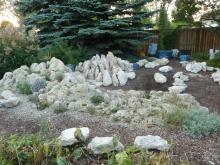
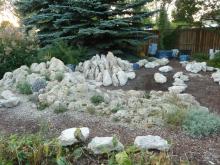
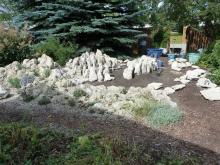
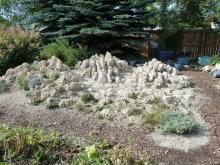
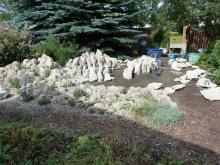
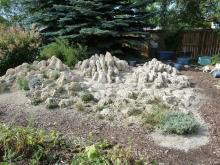
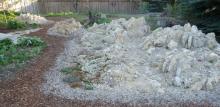

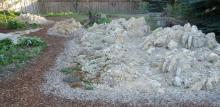


Now you have to show the result too!
I have never used tufa, don't think I can get it here in Norway either. While all my neighbours have brought stones and rocks out of their gardens I have brought the same into mine in tons. I use rock, stone, gravel, sand etc in all kind of beds, even Rhododendron plantings.